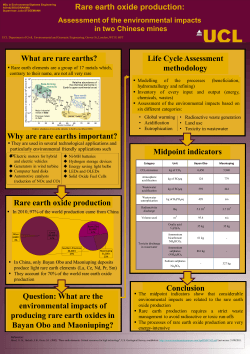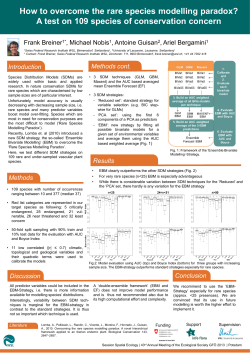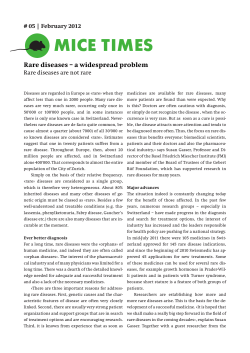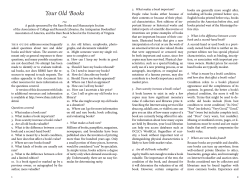
RARE EARTH ELEMENTS 101 April 2012
RARE EARTH ELEMENTS 101 April 2012 1 TABLE OF CONTENTS Page Rare Earth Elements Explained 3 Unique Properties 4 Rare Earth Applications 5 REEs on the Critical List 9 Supply and Demand Fundamentals 10 Speed to Market Critical 13 Rare Earths Value Chain 14 REE Pricing 14 Bibliography 15 NEODYMIUM 2 Rare Earth Elements (REE) Explained The rare earth elements (REE) are a group of 17 chemical (metallic) elements which appear in the periodic table. The group consists of the 15 lanthanide elements along with Yttrium and Scandium. They share many similar properties, which is why they occur together in geological deposits. The 17 REEs are found in all REE deposits but their distribution and concentrations vary. They are referred to as ‘rare’ because it is not common to find them in commercially viable concentrations. REEs generally fall into one of two categories – light rare earths (LREE) and heavy rare earths (HREE), with varying levels of uses and demand. REE mineral deposits are usually rich in either LREE or HREE, but rarely contain both in significant quantities. In general, they are vital to some of the world’s fastest growing markets: clean energy and high technology. Rare Earths Expected to be in Short Supply in the next 15 years * Neodymium, Europium, Terbium, Dysprosium, Yttrium Light Rare Earths Heavy Rare Earths (Less common and more valuable) Lanthanum (La) Accounted for 66.8% of Cerium (Ce) global demand in 2010 Praseodymium (Pr) Neodymium (Nd) Samarium (Sm) Europium (Eu) Gadolinium (Gd) Terbium (Tb) Dysprosium (Dy) Holmium (Ho) Erbium (Er) Thulium (Tm) Ytterbium (Yb) Lutetium (Lu) Yttrium (Y) Notes: Yttrium is lighter than the light rare earths, but included in the heavy rare earth group because of its chemical and physical associations with heavy rare earths in natural deposits. Promethium is a synthetic element which does not occur naturally and Scandium’s properties are quite different from the other REEs. *Ernst & Young - Technology Minerals – The rare earths race is on! - April 2011 3 Unique Properties Silvery-white or gray in colour, these metals have a high lustre and tarnish readily when exposed to air. REEs are found in most everyday applications because of their unique chemical and physical properties. New applications have arisen consistently over the past 50 years CIBC, including important environmental innovations such as catalytic converters and the development of permanent magnets which have enabled greater efficiency, miniaturization, durability and speed in electric and electronic components. Substitutes exist, but rarely work as effectively. The properties of each REE along with the percentage share of estimated global production in 2015 are summarized in the following table. REE Catalytic Magnetic Electrical Chemical Optical % Share of Estimated World Supply in 2015* Lanthanum (La) x x x x 27% x x x x 40% x x x x 5% x x x 16% Cerium (Ce) Praseodymium (Pr) Neodymium (Nd) x Samarium (Sm) x 2% Europium (Eu) x .4% x x 2% x x .2% Gadolinium (Gd) Terbium (Tb) 4 REE Catalytic Magnetic Electrical Chemical Optical % Share of Estimated World Supply in 2015* Dysprosium (Dy) x x .9% x .4% x 5% Erbium (Er) Yttrium (Y) This list excludes Holmium, Thulium, Ytterbium, Lutetium and Scandium as they represent a very small portion of total supply *Source: IMCOA - Based on Estimated Supply in 2015 of ~225,000 tons. Rare Earth Applications Often referred to as the `seeds of technology` by the Japanese, REEs are a major constituent of many advanced materials, especially in the high tech and green energy sectors where robust performance, durability and low carbon emissions are so important. Application by Individual REE Lanthanum Cerium Praseodymium Neodymium Samarium Europium Used to make rechargeable lanthanum nickel metal hydride batteries – the type used in electric and hybrid vehicles, laptop computers, cameras; fibre optics to increase transmission rates, high-end camera lenses, telescopes, binoculars – as lanthanum improves visual clarity; infrared absorbing glass for night vision goggles, used to reduce the level of phosphates in patients with kidney disease. Used to polish glass, metal and gemstones, computer chips, transistors and other electronic components; automotive catalytic converters to reduce pollution, added in glass making process to decolourize it, gives compact fluorescent bulbs the green part of the light spectrum. Used in combination with neodymium, its primary use is to make high power magnets. Used to make welder and glass blower goggles as praseodymium oxide protects against yellow flare and UV light; plastic, vibrant yellow ceramics. An elemental twin of praseodymium, the principal use of Neodymium is in the manufacture of the strongest magnets in the world. These magnets are so strong that one the size of a coin cannot be removed from a refrigerator by hand. Other important applications include laser range finders and guidance systems. Primary use is in the production of permanent magnets but also in X-ray lasers, precision guided weapons and white-noise production in stealth technology. Primarily used in phosphors used in pilot display screens, televisions (reddishorange), and energy efficient fluorescent lights (reddish-orange and blue). 5 Gadolinium Terbium Dysprosium Erbium Yttrium Used to enhance the clarity of MRI scans by injecting Gadolinium contrast agents into the patient. Used in nuclear reactor control rods to control the fission process. Primarily used in phosphors, particularly in fluorescent bulbs and tubes (yellowgreen), high intensity green emitter used in projection televisions and X-ray intensifying screens (yellow-green, violet, and blue). Most commonly used in the manufacture of neodymium-iron-boron high strength permanent magnets. Dysprosium-165 is injected into joints to treat rheumatoid arthritis. Dysprosium is used in radiation badges to detect and monitor radiation exposure. Used in glass coloring, as an amplifier in fiber optics, and in lasers for medical and dental use. Yttrium phosphors are used in energy efficient fluorescent lamps and bulbs. Yttria stabilized zirconium oxide is used in high temperature applications, such as thermal barrier coating to protect aerospace high temperature surfaces. Can increase the strength of metallic alloys. Applications in High Growth Markets Source: CIBC World Markets 6 The fastest growing markets for REEs are permanent magnets, rechargeable batteries, phosphors and polishing agents, with neodymium, praseodymium, dysprosium, yttrium, and terbium having the greatest exposure to these segments. Application Estimated Compound Annual Growth Rate 2010-2015* Permanent Magnets 16% The largest end user of REEs is the permanent magnet industry. This segment represents about 25% of total demand and is expected to grow to 30% by 2015. They are in high demand due to their strength, heat resistance and ability to maintain their magnetism over very long periods of time. Magnets made from rare earth elements, such as neodymium, praseodymium, and dysprosium are the strongest known permanent magnets. Their higher performance and smaller size enables many miniature applications, such as personal electronic devices (smart phones, ear buds, iPod music players). A miniature magnet made with neodymium causes the cell phone to vibrate when a call is received. Capacity utilization is one of the biggest challenges in the wind energy sector. Replacing gear driven turbines with powerful directdrive permanent magnet generators can increase efficiency by 25%. Some of the largest turbines require two tons of rare earth magnets, which contain about 30% REE. Rechargeable Batteries Rechargeable batteries (NiMH ) made from lanthanum, cerium, neodymium and praseodymium (combined with nickel, cobalt, manganese and/or aluminum) are used in car batteries in hybrid electric vehicles, electronic devices and power tools. Auto Catalysts Lanthanum and Cerium are used in the manufacture of catalytic converters which convert the pollutants in engine exhaust to non-toxic compounds. Fluid Cracking Catalysts 18% 8% 6% Fluid cracking catalysts, which contain lanthanum and cerium, are used in the refining of crude oil. They are essential to the process of transforming heavy molecules into more useful forms such as gasoline, jet fuel and diesel. 7 Polishing Powders 15% Cerium Oxide polishing powder is one of the best polishing materials. It is used for polishing glass, lenses, CRTs, jewels, silicon chips, TV screens and monitors. Glass Additives Cerium reduces transmission of UV light and Lanthanum increases the glass reflective index for digital camera lenses. Phosphors Europium, terbium and yttrium are REEs used extensively in the electronics industry to manufacture LCDs and colour TVs. Used as phosphors they enable colour changes as electrical currents are transmitted through them. Terbium and Europium are used in energy efficient lighting applications. Light emitting diodes (LEDs) are 80% more efficient than incandescent lighting and 40% more efficient than compact fluorescent bulbs. 4% 30% * CIBC World Markets REEs Play a Key Role in the Green Energy Sector Electric and hybrid cars can contain 20-25 pounds of rare earths, which is double that found in a standard gasoline vehicle. The battery itself is made from several pounds of rare earth compounds. REEs are also used in regenerative braking systems and electric traction motors. The motors consist of powerful magnets made from neodymium and dysprosium. 8 REEs on the Critical List Demand is driven in large part by two of the fastest growing sectors: energy and high-tech. The criticality of each element depends on the end application demand pattern. Supply and demand calculations are complicated because each REE has different applications and is produced in varying quantities. This means that certain rare earths will be in short supply and others will be in surplus, depending on the supply and demand fundamentals of the end markets. The fastest growing market segments are permanent magnets, rechargeable batteries, and phosphors, particularly given their application in the fast growing green energy and high tech segments. In 2010, The U.S. Department of Energy classified the five REEs critical to these markets to be in short supply. Four of these are the HREEs. China’s Ministry of Commerce has indicated that China’s HREEs could be depleted in the next 15-20 years. REE on the Critical List Applications Light Permanent magnets, auto catalysts, petroleum refining, lasers Permanent magnets, hybrid engines Phosphors, fuel cells, neutron absorbers Phosphors, permanent magnets Red phosphor, fluorescent lamps, ceramics, metal alloys Heavy Neodymium Dysprosium Europium Terbium Yttrium Estimated Compound Annual Growth Rate 2010-2015 16% 16% 27% 30% 30% Source: IMCOA and CIBC World Markets and Dundee Capital Markets These minerals, with the exception of Yttrium are expected to be in short supply over the next 10 years. The magnitude and duration of these shortages will mainly depend on the success of REE exploration projects. Various governments and industrial users worldwide have begun to develop strategies to safeguard their REE supplies in order to overcome future supply problems. Some industrial users have established joint ventures with mining companies. Market mechanisms should ensure serious shortages are averted in the long term. This supply gap has led to increasing attention from governments, exploration companies and end users. Short-Term Criticality Medium-Term Criticality Source: U.S. Department of Energy, Critical Materials strategy, Dec. 2010 9 Supply and Demand Fundamentals Large and Growing Market Demand for rare earth elements is growing at 9-15% a year (CIBC World Markets), and according to a report by Ernst & Young - Technology Minerals – The Race is On – April 2011, the market for REEs is currently valued at $2-3 billion and is expected to double to $4-6 billion by 2015. China Accounts for 48% of the World’s Reserves Global rare earth reserves were estimated at 114 million metric tons in 2011, with China accounting for 48%. Only a small proportion of REE deposits are of sufficient size, type and concentration to be exploited economically using existing technology. Note: IMCOA – “Reserve figures encompass a wide range of mineral qualities and do not necessarily comply with the internationally recognized codes for the definition of reserves.” China Accounts for 94% of Global Production In 2010, global REE production was about 125,000 metric tonnes; up 54% from 80,000 tonnes in 2000. China is by far the dominant producer of rare earth elements, accounting for 94% of global production. Significant amounts of REE are produced in only a few other countries, such as Brazil, India and Malaysia. More than 70% of light rare earth elements are supplied from one mine in China: the 56 million tonne Bayan Obo deposit in Inner Mongolia, which commenced production in 1957 and is the largest deposit in the world. In 2010, it produced 55,000 tons of REOs, representing 46% of Chinese production and 42% globally. Before the Bayan Obo deposit came on stream, the largest producer was Molycorp’s Mountain Pass deposit in California. However, China started selling rare earths at such low prices in the early 1990’s that the Mountain Pass mines and others in the world were unable to compete. Mining at Mountain Pass ceased in 2002 but was recently re-commissioned and is expected to return to full production in 2012. 10 China is the World’s Largest Consumer China is also the world’s leading consumer of rare earth elements, accounting for about 60% of global consumption. China Takes Measures to Protect its Supply It is believed that the resource grade of China’s Bayan Obo deposit may be dwindling – resulting in a reduced forecast over next five years. Therefore, China has taken multiple measures to protect its supply, and some feel that China could go from being a net exporter to a net importer. In 2010, China began to restrict exports so as to ensure an abundant supply for its downstream technology sector. Export quotas in 2010 were down 40% from 2009. When a single country controls almost all of the production and then reduces exports, the entire supply is threatened and prices quickly rise. The panic buying that was triggered by the reduction in export quotas resulted in rare earth prices surging to record high levels in early 2010. The significant price increases in 2010 led to a drop in demand, which in turn restored pricing stability. At the end of December 2011, the Chinese Ministry of Commerce announced that “in order to protect international demand and maintain the basic stability of rare-earth supplies, the total export quotas for 2012 will be basically the same.” China also took steps to nationalize the industry, bringing 11 REE mines under State control, and to crack down on illegal and environmentally questionable mining practices. China’s Actions Prompt a Rare Earth Race The steps taken by China have raised concerns that the world is reliant on a single source for rare earths. Currently, the world is nearly 100% dependant on Chinese exports of a commodity that is essential to certain high-tech, renewable-energy, and defense-related technologies. Thus the race is on for the rest of the world to develop rare earth deposits. The U.S. considers REEs as a strategic material and in April 2011 legislation known as Rare Earths Supply Chain Technology and Resources Transformation Act HR 1388 (RESTART) was introduced to avert a rare earth crisis by re-establishing a domestic rare earth industry. Subsequently, California based Molycorp signed a Joint Venture with Daido Steel and Mitsubishi to manufacture high power magnets. It is expected that this first non-Chinese Joint Venture should pave the way for other western producers to establish rare earth joint ventures outside of China – leading to a tripling in demand for neodymium over the next three years. (Source: Rare Earth Market - December 2011). As a result of China’s actions, two separate markets have been created – the China market and the rest of the world market (ROW). 11 Gap between Supply from China and Rest of World Demand is Growing The following chart illustrates the widening gap between the supply from China and the demand from the rest of the world: Rest of World Production Expected to Fill the Growing Gap While China accounted for 94% of production in 2011, this is expected to fall to 70% by 2015 as new projects in the rest of the world come on stream. Source: D. Kingsworth IMCOA 2011 12 Speed to Market Critical It is expected that the supply shortfall will continue for the next few years. There are insufficient REEs available to meet growing demand. Given the very attractive supply/demand fundamentals, bringing deposits into production as fast as possible is critical. While there are known deposits in countries outside of China that are potentially economic to mine, it can take 10 years to bring a deposit into production. High grade deposits close to infrastructure and in mining friendly jurisdictions are hard to come by. According to Technology Metals Research, it’s estimated that there are 165 companies with 251 projects in 24 countries. Most of these companies are small. Major REE production projects expected to come on stream in the near future are listed below: Company Lynas (Australia) Molycorp (California) Arafura (Australia) Greenland Minerals Avalon (Canada) Quest Rare Minerals Project Mount Weld Mountain Pass Nolans Bore Kvanefjeld Thor Lake Strange Lake Expected Production(mt) 22,000 40,000 20,000 44,000 10,000 12,000 Targeting Production in: 2011* 2011* 2013 2015 2015 2015 *Molycorp’s Mountain Pass and Lynas’ Mount Weld mines are expected to reach full production in 2012. Source: IMCOA IAMGOLD Advantage IAMGOLD’s rare earth resource is located one kilometre north of its Niobec niobium mine in the mining friendly jurisdiction of Quebec, Canada. The Niobec mine has been operating for more than 35 years and IAMGOLD has established excellent relations with the local community and all levels of government. The region has a long mining history and draws on an experienced and well educated pool of labour in the area. In addition to its close proximity to an existing mine infrastructure and the Saguenay River which, within a short distance of the deposit widens and deepens enough for a deep water ocean port, the Company has access to very competitive power rates of 4.5 cents per kWh. These factors, together with access to funding and development expertise provide a “speed to market” advantage. 13 The Rare Earths Value Chain – Ground to Market REEs are principally found in carbonatites, which are igneous rocks comprising more than 50% carbonate minerals. Less important sources are secondary deposits which form when rare earth and heavy minerals are concentrated by the physical weathering of primary mineralization. Most REE mines produce only REEs although there are a few where REEs are produced as a by-product. Most use large-scale techniques, involving drilling, blasting and hauling. Separation of the ore from the waste is carried out in a variety of ways. The production process is quite involved as one rare earth mineral may contain up to 17 different elements which must be separated from one another. The following diagram summarizes the basic steps of mining and processing REE. REE Pricing Prices increased dramatically in 2010 following China’s decision to reduce exports. This led to reduced demand which in turn restored pricing stability. As the world races to secure REE supply outside of China, future pricing projections indicate a strong market sustained by growing demand. ($/kg) REE Lanthanum Cerium Praseodymium Neodymium Samarium Dysprosium Europium 2009 6 4 16 16 5 107 473 Nov. 2011 60 55 60 235 87 2,000 4,000 Jan 25, 2012 62 100 250 295 150 2,600 3,850 2012(E)* 17 29 150 154 32 688 1,393 *CIBC World Markets 14 Bibliography Day, Sara. “Future Supply of Rare Earth Elements Could be Disrupted Says Geological Society of London.”. 14 November 2011. http://renewableenergyworld.com Ernst & Young. Technology Minerals. “The rare earths race is on!” April 2011. Folger, Tim. “The Secret Ingredients of Everything.” June 2011. http://ngm.national geographic.com Gibson, Matthew and Parkinson, Ian. “Once Ignored on the Periodic Table, Don’t Ignore Them Now.” CIBC World Markets. March 6, 2011 Gowing, Matt. “2011 Rare Earth Industry Update.” Mackie Research Capital Corporation. February 8, 2011. Hong, Nicole. “Rare Earths Offer a Bumpy Road to Riches.” 15 November 2011. http://www.marketwatch.com “Industry Bulletin: Chinese Ministry of Commerce Announces Rare-Earth Export-Quota Allocations for 2012.” http://avalonraremetals.com. Kingsnorth, Dudley J. “An Overview of the Rare Earths Market.” IMCOA. May 2010. Martin, Richard.”Molycorp’s $1 billion rare-earth gamble.” CNN Money. 18 November 2011. http://features.blogs.fortune.cnn.com/2011/11/18/molycorps. http://www.mineralprices.com “Molycorp to Form Rare-Earth Joint Venture With Daido Steel, Mitsubishi.” 28 November 2011. http://www.nasdaq.com “New Report on the Rare Earth Market.” 7 August 2011. www.azom.com http://reehandbook.com http://raremetalblog.com “REE – Rare Earth Elements and their Uses.” http://www.geology.com “Rare Earth Elements Briefing Note.” The Geological Society of London. http://www.geolsoc.org.uk/webdav/site/GSL/shared/pdfs/our%20views/ree%20briefing%20note%20finalv2.pdf “The Rare Earth Market: A Monthly Analysis for the Rare Earth Industry.” Core Consultants & Metal Pages. December 2011. U.S. Department of Energy, Critical Materials strategy, Dec. 2010 York, Geoffrey and Bouw, Brenda. “ The Race for Rare Metals.” The Globe and Mail 16 July 2011: B1. 15
© Copyright 2025





















